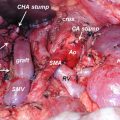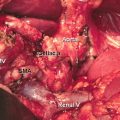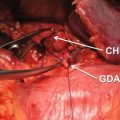Major abdominal surgery induces an immune-inflammatory response, which is accompanied by the production of reactive oxygen species (ROS) at the site of injury causing direct cellular injury, and several stress hormones and cytokines appear to amplify the inflammatory cascades. The resulting impaired vascular permeability together with excessive fluid administration can lead to fluid overload, interstitial edema, and therefore delayed recovery of gastrointestinal function and impaired anastomotic healing [34].
Traditional strategy for perioperative fluid management composed of overnight NPO with bowel preparation, sufficient fluid supply intra- and postoperatively to keep intravascular volume enough. However, fluid balance is a very important point in ERAS because salt and water overload results in prolonged ileus and increased postoperative complications including anastomotic leakage which leads to prolonged hospital stay and increased cost [34, 35]. The principle of maintaining a patient in the zone of normovolemia is to maintain a normal intravascular volume and avoid gaining weight due to excessive administration of fluid. Generally, it has been shown that postoperative complications increase when the weight gain in the postoperative period exceeds 2.5 kg (indicative of a 2.5 L cumulative fluid overload) [36]. Preoperative adequate hydration without bowel preparation, intraoperative and postoperative fluid management avoiding fluid overload, and early establishment of oral intake allow the patients to be normovolemic with zero balance [31]. Moreover, preoperative minimal NPO with carbohydrate loading and early feeding can reduce hunger, thirst, and anxiety of the patients as well as decrease postoperative insulin resistance and improve glucose control. The concept of zero-balance fluid management comes from the recent advancement in the surgical techniques allowing less bleeding with fast operation and also in the perioperative care.
Early oral feeding is a key component in ERAS. The risk factors of postoperative ileus have been identified which include increasing age, male gender, low preoperative serum albumin, acute and chronic opioid use, previous abdominal surgery, preexisting airways and vascular disease, long duration of surgery, emergency surgery, blood loss, and salt and water overload. Most of these factors increase the inflammatory response, and inflammation and edema play a major role in reducing intestinal smooth muscle contractility [37]. A number of strategies have been suggested to prevent postoperative ileus, and these have been reviewed recently and are summarized in Table 35.1 [37].
Intervention | Mechanism | Benefit |
|---|---|---|
Salt and fluid restriction | ↓ gut edema and stretch | ++ |
Carbohydrate loading | ↓ insulin resistance | ± |
Routine nasogastric tubes | Prophylactic drainage of stomach | – |
Intravenous lidocaine | Anti-inflammatory; opioid-sparing | + |
Coffee | Stimulatory effect | + |
Chewing gum | Stimulatory effect | + |
NSAIDs | Opioid sparing; anti-inflammatory | ++ |
Early enteral nutrition | Anabolic; ↓ insulin resistance stimulatory | ++ |
Enhanced recovery programs | Multimodal effect | ++ |
Laparoscopic surgery | ↓ tissue trauma; ↓ bowel handling; ↓ inflammatory reaction | ++ |
Alvimopan | μ-opioid receptor antagonist | ++ |
Mid-thoracic epidural anesthesia | ↓ inflammatory response ↓ sympathetic stimulation ↓ opioid requirement | ++ |
Early mobilization | ? anabolic effect | +/± |
Nicotine | Colonic prokinetic | + |
Daikenchuto | Anti-inflammatory on acetylcholine receptors | + |
Magnesium sulfate | Anesthetic effect | + |
Prokinetics | Prokinetic effect | ± |
In the context of the ERAS program, the adaptation of multimodal analgesic strategies aims not only to improve postoperative pain control and reduce surgical stress but also to attenuate the multiorgan dysfunction induced by unrelieved pain, reduce opioid side effects, facilitate early resumption of oral diet and early mobilization, and ultimately accelerate surgical recovery [31]. For the last decades, minimally invasive surgery (MIS) has been expanding to change the paradigm of the surgical principles dramatically. As MIS can reduce the surgical stress with less incision and pain, postoperative restoration of homeostasis can be achieved fast resulting in early discharge. Expanding MIS is a very strong supporter for ERAS program in the future.
35.3 ERAS for PD
Although still there is a concern about the real benefit of ERAS for PD, positive results with ERAS programs after PD have been published [14–25]. A meta-analysis with ten studies of ERAS programs after pancreatectomy suggested the shortened hospital stay without increased morbidity or readmission rate [15]. One systemic review analyzing eight studies reported that implementation of an ERAS protocol led to a significant decrease in length of stay, complications, and cost without increase of morbidity and mortality [14]. The reductions in hospital stay seen in ERAS studies for PD do not compare with the impressive reductions reported in ERAS studies for colorectal or liver resections. It could be argued that this reflects the high rate of morbidity following PD relative to the acknowledged lower rate of complications following colorectal and standard liver resections [23]. The reported series in ERAS studies for PD employed different protocols, respectively. In fact, the individual items of ERAS can be modified according to the diverse situations of each institute or each surgeon. In Table 35.2, the items of ERAS protocol of the author’s institute are suggested. ERAS® Society, European Society for Clinical Nutrition and Metabolism (ESPEN), and International Association for Surgical Metabolism and Nutrition (IASMEN) presented a comprehensive guideline of consensus for optimal perioperative care after PD in 2013 (Table 35.3) [26]. Available evidences and recommendations are summarized for 27 care items. As well-designed studies are very rare, many items suggested in this guideline don’t have high evidence levels. In the following session, several important items will be discussed in detail. Issues concerning pancreatic fistula, delayed gastric emptying, intra-abdominal drain management, etc. will be discussed in other chapters of this book.
Table 35.2
ERAS protocol for PD of National Cancer Center, Korea
Before operation |
Nutritional assessment (preoperative nutritional support if needed) |
Counseling for psychology, rehabilitation and diabetes, etc. |
Epidural catheter insertion (till POD #7) |
Day of operation |
Oral carbohydrate loading until 2 h before operation |
No enema |
Preoperative heparin, 5,000 units subcutaneously (till POD #7) |
Nasogastric tube after induction of anesthesia (removal after operation) |
Perioperative antibiotics (single shot after anesthesia) |
Somatostatin analogue (till POD #3) |
One Jackson-Pratt (JP) drains |
POD 1 |
Start sips of water |
POD 2 |
Free sweet fluid (juice or water with honey) |
Removal of Foley |
Start ward ambulation |
POD 3–4 |
Semifluid diet (150 Cal/day) |
Reduce IV fluid (<1.5 L) |
Removal of JP drain (if drain amylase <1,000 iu) |
POD 5–6 |
Semisolid diet (400 Cal/day) |
Reduce IV fluid (<1 L) |
POD 7–8 |
Semisolid diet (800 Cal/day) |
Stop IV fluid |
POD 9–10 |
Semisolid diet (1,200 Cal/day) |
Counseling for psychology, rehabilitation, and diabetes |
Nutritional assessment |
Check dynamic CT |
Consider discharge |
Item | Summary and recommendations | Evidence level | Recommendation grade |
|---|---|---|---|
Preoperative counseling | Patients should receive dedicated preoperative counseling routinely | Low | Strong |
Perioperative biliary drainage | Preoperative endoscopic biliary drainage should not be undertaken routinely in patients with a serum bilirubin concentration <250 μmol/l | Moderate | Weak |
Preoperative smoking and alcohol consumption | For alcohol abusers, 1 month of abstinence before surgery is beneficial and should be attempted. For daily smokers, 1 month of abstinence before surgery is beneficial. For appropriate groups, both should be attempted | Alcohol abstention: low | Strong |
Preoperative nutrition | Routine use of preoperative artificial nutrition is not warranted, but significantly malnourished patients should be optimized with oral supplements or enteral nutrition preoperatively | Very low | Weak |
Perioperative oral immunonutrition (IN) | The balance of evidence suggests that IN for 5–7 days perioperatively should be considered because it may reduce the rate of infectious complications in patients undergoing major open abdominal surgery | Moderate | Weak |
Oral bowel preparation | Extrapolation of data from studies on colonic surgery and retrospective studies in PD show that MBP has no proven benefit. MBP should not be used | Moderate | Strong |
Preoperative fasting and preoperative treatment with carbohydrates | Intake of clear fluids up to 2 h before anesthesia does not increase gastric residual volume and is recommended before elective surgery. Intake of solids should be withheld 6 h before anesthesia. Data extrapolation from studies in major surgery suggests that preoperative oral carbohydrate treatment should be given in patients without diabetes | Fluid intake: high Solid intake: low Carbohydrate loading: low | Fasting: strong Carbohydrate loading: strong |
Preanesthetic medication | Data from studies on abdominal surgery show no evidence of clinical benefit from preoperative use of long-acting sedatives, and they should not be used routinely. Short-acting anxiolytics may be used for procedures such as insertion of epidural catheters | No long-acting sedatives: moderate | Weak |
Anti-thrombotic prophylaxis | LMWH reduces the risk of thromboembolic complications, and administration should be continued for 4 weeks after hospital discharge. Concomitant use of epidural analgesia necessitates close adherence to safety guidelines. Mechanical measures should probably be added for patients at high risk | High | Strong |
Antimicrobial prophylaxis and skin preparation | Antimicrobial prophylaxis prevents surgical-site infections, and should be used in a single-dose manner initiated 30–60 min before skin incision. Repeated intraoperative doses may be necessary depending on the half-life of the drug and duration of procedure | High | Strong |
Epidural analgesia | Mid-thoracic epidurals are recommended based on data from studies on major open abdominal surgery showing superior pain relief and fewer respiratory complications compared with intravenous opioids | Pain: high Reduced respiratory complications: moderate | Weak |
Overall morbidity: low | |||
Intravenous analgesia | Some evidence supports the use of PCA or intravenous lidocaine analgesic methods. There is insufficient information on outcome after PD | PCA: very low I.V. Lidocaine: moderate | Weak |
Wound catheters and transversus abdominis plane block | Some evidence supports the use of wound catheters or TAP blocks in abdominal surgery. Results are conflicting and variable, and mostly from studies on lower gastrointestinal surgery | Wound catheters: moderate TAP blocks: moderate | Weak |
Postoperative nausea and vomiting (PONV) | Data from the literature on gastrointestinal surgery in patients at risk of PONV show the benefits of using different pharmacological agents depending on the patient’s PONV history, type of surgery, and type of anesthesia. Multimodal intervention during and after surgery is indicated | Low | Strong |
Incision | The choice of incision is at the surgeon’s discretion, and should be of a length sufficient to ensure good exposure | Very low | Strong |
Avoiding hypothermia | Intraoperative hypothermia should be avoided by using cutaneous warming, i.e., forced-air or circulating-water garment systems | High | Strong |
Postoperative glycemic control | Insulin resistance and hyperglycemia are strongly associated with postoperative morbidity and mortality. Treatment of hyperglycemia with intravenous insulin in the ICU setting improves outcomes but hypoglycemia remains a risk. Several ERAS protocol items attenuate insulin resistance and facilitate glycemic control without the risk of hypoglycemia. Hyperglycemia should be avoided as far as possible without introducing the risk of hypoglycemia | Low | Strong |
Nasogastric intubation | Pre-emptive use of nasogastric tubes postoperatively does not improve outcomes, and their use is not warranted routinely | Moderate | Strong |
Fluid balance | Near-zero fluid balance, avoiding overload of salt and water results in improved outcomes. Perioperative monitoring of stroke volume with transesophageal Doppler to optimize cardiac output with fluid boluses improves outcomes. Balanced crystalloids should be preferred to 0.9% saline | Fluid balance: high esophageal Doppler: moderate Balanced crystalloids vs. 0.9% saline: moderate | Strong |
Perianastomotic drain | Early removal of drains after 72 h may be advisable in patients at low risk (i.e., amylase content in drain <5,000 U/L) for developing a pancreatic fistula. There is insufficient evidence to recommend routine use of drains, but their use is based only on low-level evidence | Early removal: high | Early removal: strong |
Somatostatin analogues | Somatostatin and its analogues have no beneficial effects on outcome after PD. In general, their use is not warranted. Subgroup analyses for variability in the texture and duct size of the pancreas are not available | Moderate | Strong |
Urinary drainage | Suprapubic catheterization is superior to transurethral catheterization if used for >4 days. Transurethral catheters can be removed safely on postoperative day 1 or 2 unless otherwise indicated | High | For suprapubic: weak Transurethral catheter out POD 1–2: strong |
Delayed gastric emptying (DGE) | There are no acknowledged strategies to avoid DGE. Artificial nutrition should be considered selectively in patients with DGE of long duration | Very low | Strong |
Stimulation of bowel movement | A multimodal approach with epidural and near-zero fluid balance is recommended. Oral laxatives and chewing gum given postoperatively are safe, and may accelerate gastrointestinal transit | Laxatives: very low Chewing gum: low | Weak |
Postoperative artificial nutrition | Patients should be allowed a normal diet after surgery without restrictions. They should be cautioned to begin carefully and increase intake according to tolerance over 3–4 days. Enteral tube feeding should be given only on specific indications, and parenteral nutrition should not be employed routinely | Early diet at will: moderate | Strong |
Early and scheduled mobilization | Patients should be mobilized actively from the morning of the first postoperative day and encouraged to meet daily targets for mobilization | Very low | Strong |
Audit | Systematic improves compliance and clinical outcomes | Low | Strong |
35.3.1 Preoperative Biliary Drainage (PBD)
PBD has long been considered a routine to reduce jaundice in patients with bile duct obstruction. Several retrospective studies have suggested that PBD could reduce morbidity and mortality after PD [38–40]. However, since the 1990s, despite effective reducing jaundice, several large-scale retrospective studies reported that PBD did not only failed to show a clinical benefit but also associated with an adverse impact on perioperative outcome, especially increasing infectious complications [41–43]. These findings were repeatedly confirmed in several meta-analysis [44–46], and the latest one published in 2015 including 6,286 cases (8 RCTs, 13 prospective, and 20 retrospective studies) demonstrated that PBD resulted in a significant increase in the risk of postoperative infectious complication, wound infection, and delayed gastric emptying compared with non-PBD [38]. Recently, more elaborated RCT comparing PBD (endoscopic biliary stent of 7-Fr. plastic stent) with non-PBD published in 2010 has suggested that PBD was associated with more serious complications (74% vs. 37%) and therefore should not be performed routinely [47]. Nevertheless, PBD has been incorporated before PD in many centers which is partly because several limitations of previous studies make to draw a conclusion difficult, heterogeneity of study design, types of disease, types of PBD routes or drainage duration, etc. In case of poor patient’s condition, presence of cholangitis or jaundice complications such as pruritus, coagulation/nutrition/renal problems, or anticipating neoadjuvant treatment, PBD (endoscopic or percutaneous) should be considered. Compared with PTBD, endoscopic stent shows more procedure failure, procedure-related complications such as pancreatitis and cholangitis, and stent occlusion which can be decreased in self-expandable metal stent (SEMS). PTBD has a big concern about tract seeding which was reported to be 5.2% in a large-series study [48]. In conclusion, PBD before PD should not be a routine any longer when early operation is possible.
Stay updated, free articles. Join our Telegram channel

Full access? Get Clinical Tree






